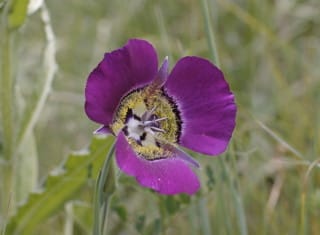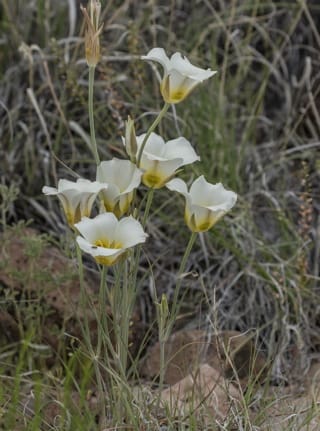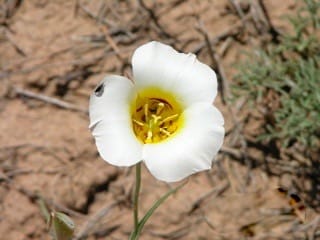Initially this guide displays common flowers of all colors that are blooming right now in our area. Use the selectors to view rare species, to view flowers blooming any time, to restrict the output to a certain color, or to search by name.
The Jemez Mountain Herbarium located at PEEC has a specimen collection of over 1,000 plant species that are found in the Jemez Mountain region. This guide was developed as a subset of this collection to help in the identification of the most prevalent flowering plants in Los Alamos County. Most of the plants shown here are native to the area, though a few were introduced to the region.
Monocot and both simple and composite flowering dicots are covered in this guide. This information is included in each description and potentially makes it easier to identify the different plants.
- monocot – seed has 1 embryonic leaf; flower parts com in multiples of 3; leaves have parallel veins
- dicot – seed has 1 embryonic leaves; flower parts com in multiples of 4 or 5; leaves have scattered veins
- simple flower – single, symmetric flowers; usually 3 to 6 petals that emerge from the flower center
- composite flower – multiple, tiny flowers arranged on a single base, typically rays around a disc; each tiny flower has its own seed
Most of the plants represented here are classified as forb/herb which are plants without significant woody growth. However, some flowering shrubs and trees have been included. Many of the later can also be found in the PEEC Tree Guide. This guide does not include any noxious weeds from the area. These are covered in the PEEC Invasive Plant Guide.
You can get additional information on local blooms by joining PEEC Wild Plants. More detailed descriptions can be found in Plants of the Jemez Mountains Volumes 2 and 3, which are available in the PEEC gift shop.
Flower References
American Southwest Plants
Annotated Checklist and Database for Vascular Plants of the Jemez Mountains
Colorado Rocky Mountain Wildflowers
Flora of North America
Foxx, T., Martin, C., and Hoard, D., 2018 Plants of the Jemez Mountains Volume 2: Wildflowers: Showy Monocots and Common Dicots.
Foxx, T., Martin, C., and Hoard, D., 2019 Plants of the Jemez Mountains Volume 3: Composites.
eNature
Lady Bird Johnson Wildflower Center
National Garden Association
Native Plants Society of New Mexico
New Mexico Flora
Rocky Mountain Flora
Southwest Desert Flora
Wildflowers of the United States
US Department of Agriculture Natural Resources Conservation Services
US Forest Service
Subject Area Experts (all guides)
Steve Cary (butterflies)
Beth Cortright (insects)
Terry Foxx (invasive plants)
Leslie Hansen (mammals)
Richard Hansen (fish, mammals)
Dorothy Hoard (butterflies, trees)
Chick Keller (flowers, herbarium)
Shari Kelley (geology)
Kirt Kempter (geology)
Garth Tietjen (reptiles)
David Yeamans (birds)
Web Development and Content Management
Pat Bacha
Jennifer Macke
Graham Mark
Akkana Peck
Contact
Please contact us for local nature questions and sightings. We welcome comments, corrections, and additions to our guides.
For more information about local nature, please visit our Nature Blog or subscribe to PEEC This Week.
Make Selection
 Photo: Craig Martin  Photo: Chick Keller | Mariposa LilyCAGU (Calochortus gunnisonii)Family: Liliaceae (Lilies) Size: up to 18 in (46 cm) Growth: forb/herb; perennial Blooms: Jul 14, 2000 - Aug 27, 2000 Flower: simple; purple to white; dark purple markings; large, showy, and bell-shaped; sepals shorter than petals, filaments shorter than anthers Leaf: monocot; thin grass-like; hairless; basal leaves wither with the season Fruit: linear, erect capsule; seeds flat and inflated Status: native; common Habitat: foothills, montane, subalpine, meadows Typical location: Camp May The genus of the plant (Calochortus comes from the Greek for “beautiful” and “grass”, referring to its exotic flowers and thin leaves. The flower is distinguished by a broad band of yellow hairs above an elliptically-shaped structure on each petal. The plant sprouts from bulbs that are buried deep within the soil. The bulbs are edible. Info Photos Distribution |
 Photo: Craig Martin  Photo: Jerry Oldenettel | Sego Lily, Nuttall's MariposaCANU3 (Calochortus nuttallii)Family: Liliaceae (Lilies) Size: 6 - 18 in (15 - 46 cm) Growth: forb/herb; perennial Blooms: May 15 - Jun 30 Flower: simple; white with yellow base and red ring; sometimes pink or tinged with pink; 1 to 3 showy tulip-like flowers Leaf: monocot; curved and grasslike; alternate arrangement Fruit: upright, lance-shaped capsules Status: native; common Habitat: canyon, grassland, scrubland --- sandy soils, hot dry areas at up to 8,000 ft (2,500 m) elevations Typical location: Red Dot Trail, Ancho Canyon The common name for this plant (Sego) comes from the Shoshonean word for “edible”. The bulbs can be dried for use in winter, eaten raw, or roasted. The flowers have been used ceremonially. Info Photos Distribution |
